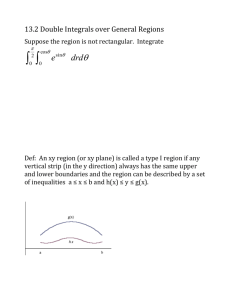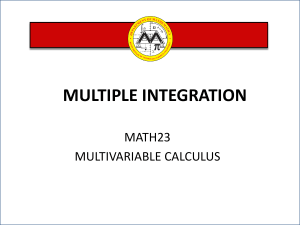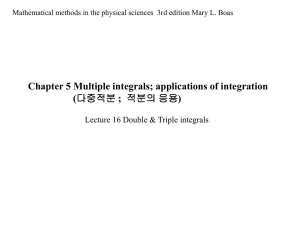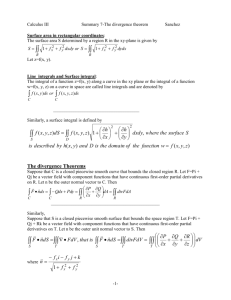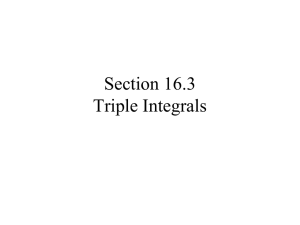HELM Workbook 27 (Multiple Integration) EVS Questions
advertisement
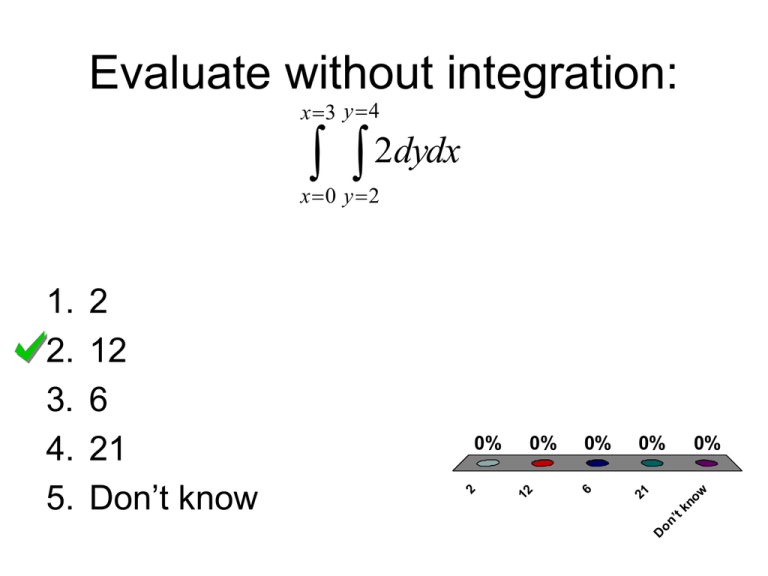
Evaluate without integration: x 3 y 4 2dydx x 0 y 2 0% no w 0% ’t k on D 0% 21 0% 6 0% 12 2 12 6 21 Don’t know 2 1. 2. 3. 4. 5. Evaluate without integration: y 2 x 11 dydx y 1 x 7 0% no w 0% ’t k on D 0% 22 0% 14 0% 7 4 7 14 22 Don’t know 4 1. 2. 3. 4. 5. 1. Which of the following integrals does not make sense? 2 3 z f ( x, y, z )dxdzdy 1 y 1 0 2. 4 x2 x4 f ( x, y, z)dydxdz 3. 0 4. 9 1 y 2 x 2 0 f ( x, y, z)dzdxdy 3 0 0 0 0 0 4 1 1 z 2 f ( x, y, z)dxdydz 3 1 z 2 y 2 2 1 z 2 2 1 1 0 1 b d g ( x ) h ( y ) dydx can be written as a c b d a c g ( x)dx h( y )dy. 1. True 2. False 3. Don’t know 0 ls e no w 0 D on ’t k Fa Tr ue 0 What physical quantity does the surface integral f ( x, y)dA represent if A f(x, y)=1? 1. Integral represents the mass of a plane lamina of area A. 2. Integral represents the moment of inertia of the lamina A about the xaxis. 3. Integral represents the area of A. 0% 1 0% 2 0% 3 What physical quantity does the surface integral f ( x, y)dA represent if f(x, y)=y2ρ(x,y)? A 1. Integral represents the mass of a plane lamina of area A. 2. Integral represents the moment of inertia of the lamina A about the xaxis. 3. Integral represents the area of A. 0% 1 0% 2 0% 3 What physical quantity does the surface integral f ( x, y)dA represent if A f(x, y)=ρ(x,y)? 1. Integral represents the mass of a plane lamina of area A. 2. Integral represents the moment of inertia of the lamina A about the xaxis. 3. Integral represents the area of A. 0% 1 0% 2 0% 3 If you change the order of integration, which will remain unchanged? 1. The integrand 2. The limits 3. Don’t know 0% 1 0% 2 0% 3 4 3 Evaluate I 3 y 2dydx. 2 1 24 32 44 56 Don’t know 0% no w 0% D on ’t k 56 0% 44 0% 32 0% 24 1. 2. 3. 4. 5. 4 Evaluate I 1 2 cos ddr. 1 0 1. 2. 3. 4. 5. 3π-12 3π 5π 3π+12 Don’t know Evaluate 16 x V 2 yzdV region enclosed by 0 x 2,0 y 1,0 z 3. 3 6 9 12 None of these. 0 on e of th es 12 e. 0 N 0 9 0 6 0 3 1. 2. 3. 4. 5. where V is the Which diagram best represents the 1 area of integration of 1. x . 3 y 2 x dydx 0 0 2. 0% no w ’t k on D Don’t know 0% 2 3. 1 0% Which diagram best represents the 1 x2 area of integration of . 3 x 2 y d ydx 2 0 0 3. 0% 0% 4 0% 3 0% 2 4. 2. 1 1. Which diagram best represents the x2 y x region or integration of 0% 0% 0% 0% 4 4. x 1 y 1 3 3. . y x dydx 2 2. 1 1. 2 Which diagram best represents the x region or integration of y 0 x 2. 1. 1 1 dydx. 4. 0 4 0 3 0 2 0 1 3. 2 Which diagram best represents the 3 region or integration of . ( 3 x y ) dydx 2 1 6 2 x 4. 0% 0% 4 0% 3 0% 2 3. 2. 1 1. 6 What double integral is obtained when the order of integration is x 3 y x ( y 3)dydx? reversed 1. x 0 y 0 y 3 x y 2 y 3 x 3 ( y 3)dxdy y 0 x y 2 y 3 x y 2 ( y 3)dxdy y 0 x 0 4. y 3 x 3 ( y 3)dydx0% y 0 x y 2 0% 0% 0% 4 2. 3. 3 x 3 2 y 0 1 ( y 3)dxdy What double integral is obtained when the order of integration is x 3 y 3 x reversed 1. y 3 x x)dydx ? x 0 y 0 x 3 2 ( y x)dxdy y 0 x 0 (y 2 2. y 3 x 3 y 2 ( y x)dxdy y 0 x 0 3. y 3 x 3 4. y 3 x 3 y 2 ( y x)dxdy 0% 0% 0% 0% 4 3 y 0 x y 2 y 0 x 3 y 1 2 ( y x)dxdy What double integral is obtained when the order of integration is 3 6 (3 x y reversed 3 2 ( 3 x y )dxdy 62 x 0 3 2 ( 3 x y )dydx 0 3 y 2 4. 6 3 2 ( 3 x y )dxdy 0 3 y 2 0% 0% 0% 0% 4 6 6 3 3. 2. 2 0 3 y 2 1 6 2 ( 3 x y )dxdy )dydx ? 0 6 2 x 1. 3 2 Which of the following integrals 3 7 y 1. 7 3 y are equal to f ( x, y, z)dzdydx? f ( x, y, z)dzdxdy 2. 1 1 1 1 1 1 7 3 y 3. 3 7 y f ( x, y, z)dzdydx 1 1 1 f ( x, y, z)dxdydz 4. 1 1 1 3 7 7 1 1 1 0% 0% 0% 5 0% 4 f ( x, y, z)dydzdx 0% 3 1 1 z 2 3 7 z f ( x, y, z)dydzdx 1 5. Which of the following integrals is 3 4x 0 0 4x 3 f ( x, y)dxdy 0 3 5. 4x 3 f ( x, y)dydx 0 0 f ( x, y)dxdy 0 y 4 4. y 12 4 f ( x, y)dxdy 0% 0 0 0% 0% 0% 0% 5 y 12 4 12 3 4 3. 2. 3 0 0 2 f ( x, y )dxdy 1 1. equal to f ( x, y)dydx ? Which dose not describes the graph of the equation r=cos θ? Line Circle Spiral Rose os e 0% R ir a l 0% Sp ir c le 0% C ne 0% Li 1. 2. 3. 4. Convert the integral to polar 2 2 a 2 ay x 2 coordinates x dydx : 0 0 1. 2 a sin 2 2 r cos drd 0 0 2. 2 2 a sin 3. 3 2 r cos d dr 0 0 2 2 a sin 4. r 0 0 3 cos drd 3 0% 0% 0% 0% 4 2 2 a sin 3 0 2 0 1 3 2 r cos drd Convert the integral to polar a a2 x2 0 0 coordinates 3xdydx : 1. a 2 3 r cosdrd 2. 0 0 a 3. 3rdrd 0 0 2 a 2 r cos drd 4. 0% 0% 0% 4 0 0 cosdrd 0% 3 3r 2 2 2 a 1 0 0 Integrate the function f ( x, y) x xy over the part of the quadrant 2 2 x 0, y 0, x y 1 in polar coordinates. 3 2 1. 2 1 4 r cosdrd 0 0 2. 2 1 3. 3 r cosdrd 0 0 1 4 r cos drd 0 0 0% 0% 0% 4 3 r cos drd 0% 3 1 2 4. 1 0 0 Which of the following integrals 2 is equivalent to rd dr ? 1. 0 dydx 0 4 x 2 4 x 2 0 0 4 y 2 4 y 2 dxdy 0 0 0 0 0 0 4 2 3 0 4. 2 dxdy 2 2 dydx 3. 2 2. 1 2 0 0 2 3 Evaluate the integral 2x e 3 y2 dydx . 2 0 1. 0 2. 17.63218 3. Cannot be done algebraically 0% 1 0% 2. 0% 3 Evaluate the volume under the surface given by z=f(x, y)=2xsin(y) over the region bounded above by the curve y=x2 and below by the line y=0 for 0≤x≤1. 1. 2. 3. 4. 0.982 1.017 0.983 1.018 0% 1. 0% 2. 0% 3. 0% 4. Evaluate f(x, y)=x2y over the quadrilateral with vertices at (0, 0), (3, 0), (2, 2) and (0,4) 1. 17 6 3. 113 6 2. 49 6 4. 145 6 0% 1 0% 2 0% 3 0% 4 Find the volume under the plane z=f(x, y)=3x+y above the rectangle 0% no w 0% ’t k on 0% D 0% 13 /3 0% 10 11/3 7 10 13 Don’t know 11 1. 2. 3. 4. 5. 1 y 3. 7 0 x 1, A tetrahedron is enclosed by the planes x=0, y=0, z=0 and x+y+z=6. Express this as a triple integral. 1. 6 6 x 6 x y f ( x, y, z)dydzdx 0 0 0 2. 6 6 z 6 x z 3. f ( x, y, z)dzdydx 0 0 6 6 6 0 f ( x, y, z )dzdydx 0 0 0 4. 6 6 x 6 x y f ( x, y, z)dzdydx 0 0 0 0% 1 0% 0% 2 3 0% 4 A tetrahedron is enclosed by the planes x=0, y=0, z=0 and x+y+z=6. Find the position of the centre of mass. 1. 3 3 3 , , 4 4 4 3. 3 3 3 , , 2 2 2 2. 1,1,1 4. 9 9 9 , , 4 4 4 0% 1 0% 2 0% 3 0% 4 Which of the following represents the 4 x 1 double integral 3xydydx after the 0 0 inner integral has been evaluated? 1. 4 3 2 3 0 2 ( x x x2. )dx 4 3. 4 1 2 3 ( x x x )dx 0 2 3 3 0 2 ( x x)dx4. 4 3( x 0 3 x)dx 0% 1 0% 2 0% 3 0% 4 Which of the following represents the 3 2x double integral 7 x ydydx after the 3 0 1 inner integral has been evaluated? 1. 3 5 3 7 ( 4 x x )dx 0 2. 3 7 6 3 ( 4 x x ) dx 0 2 3. 3 7 5 3 0 2 (4 x x 4.)dx 3 7( 2 x 0 5 x )dx 3 0% 1 0% 2 0% 3 0% 4 Find the moment of inertia about the y-axis of a cube of side 2, mass M and uniform density. 1. 8 M 3 2. 40 M 3 3. 64 M 3 4. Don’t know 0% 1 0% 0% 2 3 0% 4 Find the centre of pressure of a rectangle of sides 4 and 2, as shown, immersed vertically in a fluid with one of its edges in the surface. 1. 4 3 4. Don’t know 0% 0% 0% 0% 4 8 1, 3 2, 3 2. 3. 2 4 3 1 1 , 2 A rectangular thin plate has the dimensions shown and a variable density ρ, where ρ=xy. Find the centre of gravity of the lamina. 1. 4. 4 , 2 3 5. Don’t know 0% 0% 0% 0% 0% 5 4 3 4 1, 3 , 2 4 3 3. 2. 2 3 4 1 1,
